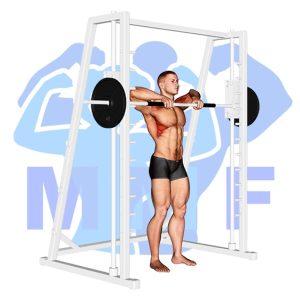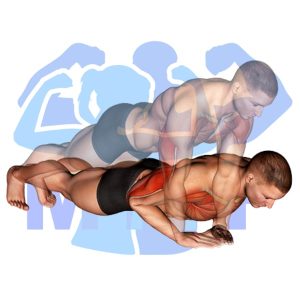If you have been struggling with developing your shoulders, specifically your rear deltoids, you might have heard about the seated dumbbell rear lateral raise. However, it is not uncommon to face an issue with executing the exercise correctly, leading to poor results or even worse, injuring yourself. The good news is that you are not alone in this struggle, and the root cause of this problem might be due to the improper execution or underdeveloped muscles. In this blog post, we will explore the proper technique and modifications you can make to your training routine to enhance your rear deltoid development and execute the seated dumbbell rear lateral raise correctly.
Seated Dumbbell Rear Lateral Raise Summary
- Primary Muscles: Deltoid – Lateral
- Secondary Muscles: Deltoid – Anterior, Serratus Anterior, Trapezius – Lower, and Trapezius – Middle
- Equipment: Dumbbells and Bench
- Mechanics Type: Isolation
- Force: Push
- Utility: Auxiliary

Seated Dumbbell Rear Lateral Raise Instructions
- Grip the dumbbells and have a seat at the end of a flat bench or chair with your legs out in front of you.
- Start by picking up the dumbbells and leaning forward so that they are under your legs and near the ground.
- Next while keeping you back and elbows tight, lift the dumbbells up out to the side.
- After you have reach parallel with the deck, pause, then lower them back dow to the starting position.
- Do it again to executed your required repetitions.
Video Tutorial
Seated Dumbbell Rear Lateral Raise Muscles
Target (Agonist)
Synergists
Dynamic Stabilizers
- None
Stabilizers
- Levator Scapulae
- Trapezius – Upper
- Wrist Extensors
Antagonist Stabilizers
- None

Benefits of Seated Dumbbell Rear Lateral Raise
The Seated Dumbbell Rear Lateral Raise is an excellent exercise for strengthening the lateral deltoid muscles. When performed correctly, this exercise targets the lateral deltoids and helps to improve shoulder stability and mobility. Additionally, it can help to reduce the risk of injury and improve overall shoulder strength. By engaging the lateral deltoids, this exercise helps to build strength and improve muscular endurance in the shoulder area. Furthermore, it is a safe exercise that can be done with light weights, making it suitable for both beginners and advanced exercisers. Performing this exercise regularly can help to improve posture and overall shoulder health.
Tips for Performing Seated Dumbbell Rear Lateral Raise
Should you desire to obtain the most effective results, you need to stick to these basic tips. Most Importantly, in case you desire to avoid getting an injury, you ought to implement these tips.
- Selecting Your Recovery Period To Be Small, But You Will Nonetheless Accomplish A Solid Whole Set. Every time your rest period is to small you could be unable to accomplish your whole set, in the event it is way too prolonged you can be merely being inefficient.
- Prepare dumbbells with weight that will permit for a complete contraction and extension.
- Breathe In When You Extend Your Muscle Groups And Exhale When You Flex Your Muscle.
- At All Times Incorporate Maximum Range Of Motion. By using complete range of motion you will certainly ensure that that you exercise your complete muscle and that you keep your flexibility.
Benefits and Tips Video
Frequent Mistakes To Avoid
You will want to keep from making these general issues to build and maintain excellent technique and see rapid gains. Also, when you stop these problems you will minimize the prospect of developing injuries.
- You Must Not Speed Through Your Workout. Every time you speed through your exercise you more likely to use poor form and accidents.
- Don’t Omit A Warm-Up. getting the blood flowing to your Muscle tissue is the Quickest way to prevent personal injury.
- Don’t Cheat. In the majority of the time, cheating is using momentum as a substitute for the strain of your primary muscle tissue. Once in a while, some cheating on your last rep can be fine to overload your muscle, but not for more than one or two reps.
Find More Dumbbell Exercises Here
Variations and Complementary Exercises
If you are looking for a few variations to the Seated Dumbbell Rear Lateral Raise, or would like to try some complementary or alternative exercises, here are some options to consider.
Single Arm Lateral Cable Raises

Single Arm Lateral Cable Raises are an excellent alternative or complementary exercise to the Seated Dumbbell Rear Lateral Raise. This exercise involves standing with one foot slightly in front of the other and facing away from a cable machine. Grasp the cable handle with one arm and extend the arm out to the side, at shoulder level, before returning it back to the starting position. This exercise helps strengthen the deltoids and traps, which are muscles that are essential for the Seated Dumbbell Rear Lateral Raise. Additionally, this exercise can be performed with heavier weights than the Seated Dumbbell Rear Lateral Raise, allowing for greater gains in strength and muscle mass.
Single Dumbbell Front Raise

The Single Dumbbell Front Raise is a great alternative or complementary exercise to the Seated Dumbbell Rear Lateral Raise. This exercise targets the anterior deltoids, as well as the pectoral muscles and triceps. To perform this exercise, stand with your feet shoulder-width apart and hold a dumbbell in each hand. With a slight bend in the elbow, lift the dumbbell in front of you until your arms are parallel to the ground. Lower it slowly back to the starting position and repeat for the desired number of reps. The Single Dumbbell Front Raise is a great way to mix up your shoulder routine and target different muscles than the Seated Dumbbell Rear Lateral Raise.
Smith Machine Upright Row

The Smith Machine Upright Row is an effective exercise to complement or provide an alternative to the Seated Dumbbell Rear Lateral Raise. This exercise is performed by standing in front of a Smith Machine and grasping the bar with an overhand grip, slightly wider than shoulder-width apart. The bar is then pulled up to the chest, keeping the elbows pointed outward, before slowly lowering the bar to the original starting position. This exercise helps to strengthen the muscles of the shoulders, upper back, and arms while also improving overall posture.
Check Out These Top Dumbbell Exercises
Standing Cable Crossover Delt Fly

The Standing Cable Crossover Delt Fly is an excellent alternative or complementary exercise for the Seated Dumbbell Rear Lateral Raise. This exercise is performed by standing between two cable machines and pulling the cables across the body, with the arms slightly bent. This exercise targets the deltoids, making it perfect for building shoulder strength and size. It also helps to improve posture, as it engages the core muscles while focusing on the shoulders. Additionally, the motion of this exercise resembles the motion of the Seated Dumbbell Rear Lateral Raise, making it a great substitution or supplement to help achieve similar results with a different exercise.
Alternating Dumbbell Raise

Alternating Dumbbell Raise is an effective exercise to target the same muscles as Seated Dumbbell Rear Lateral Raise. It is a great complementary or alternative exercise for this move, as it requires the same muscles to be engaged to complete the exercise. This exercise involves standing with your feet shoulder-width apart and holding a dumbbell in each hand with your palms facing inwards. With your arms slightly bent, lift one arm up to shoulder level while keeping the other arm stationary. Lower the lifted arm back down and then lift the other arm up. This can be done in alternating sets or both arms can be lifted at the same time. By engaging the same muscles as Seated Dumbbell Rear Lateral Raise, Alternating Dumbbell Raise can help to build strength and power in the shoulders.
Alternating Dumbbell Vertical Front Raise

The Alternating Dumbbell Vertical Front Raise is a great exercise to complement or substitute for the Seated Dumbbell Rear Lateral Raise. This exercise targets the anterior deltoids, as well as the supraspinatus, infraspinatus, and teres minor muscles of the rotator cuff. It is performed by holding a pair of dumbbells at your sides, palms facing each other. Keeping your elbows slightly bent and your back straight, lift one dumbbell at a time towards your chin, alternating arms each rep. This exercise is a great alternative for those who don’t have access to a rear lateral raise machine.
Find More Shoulders Exercises Here
Opposing Complementary Exercises
It is important to remember to always engage opposing muscle groups when exercising, in order to create balance and prevent injury. To complement the exercise Seated Dumbbell Rear Lateral Raise, consider adding the following exercises to your routine that work the opposing muscles:
Diamond Push Up

Diamond Push Up is an excellent complementary exercise to the Seated Dumbbell Rear Lateral Raise, as it utilizes the opposite muscle group. By pushing up with your hands and feet, you are engaging your chest, triceps, and shoulders while stretching the opposing muscles of your back and rear deltoids. This exercise is great for developing upper body strength and muscular balance between opposing muscle groups.
Incline Push Up

The incline push up is a great complimentary exercise to the seated dumbbell rear lateral raise. This exercise targets the chest and triceps muscles, which are the opposing muscle group to the shoulders and upper back targeted by the seated dumbbell rear lateral raise. This combination is a great way to build strength and stability in both of these opposing muscle groups. By performing both exercises, you can create balance in your upper body and ensure that your muscles are working together in harmony.
Narrow Push Up

Narrow Push Up is a great complementary exercise to Seated Dumbbell Rear Lateral Raise, as it targets the opposing muscle groups. Specifically, Seated Dumbbell Rear Lateral Raise focuses on the posterior deltoids, whereas Narrow Push Up focuses on the anterior deltoids. Additionally, Narrow Push Up is an ideal exercise for building a strong upper body, as it works both the chest and triceps muscles. Furthermore, this exercise can be performed with or without a weight vest to increase the difficulty level. With its combination of pushing and pulling movements, Narrow Push Up is a great way to supplement Seated Dumbbell Rear Lateral Raise and create a balanced workout routine.
Stronger Shoulders, Healthier You!
Building stronger shoulders is crucial for overall upper body strength and maintaining good posture. Strong shoulders help prevent injuries, improve range of motion, and give nice shape to the upper body. The seated dumbbell rear lateral raise is a great exercise for targeting the rear deltoids, and it can easily be done at home or in the gym. By incorporating this exercise into your routine, you’ll be on your way to a healthier and more balanced upper body. Just be sure to start with a light weight and gradually increase as your strength improves.
References: Wikipedia | ExRx.net | PubMed.gov | Comprehensive List of Shoulders Dumbbell Exercises




